We fairly randomly rang our travel agent for destinations available on short notice, and were presented with a list of all the usual (warm island in the Mediterranean) suspects, and one odd one out, 100km north of the Arctic Circle in Finland.
A Finnair Welcome
Very shortly after that we were on board a Finnair flight for Helsinki, where we were to transfer to an inland plane for the last 1000 miles or so to Kittila.
Flying with Finnair was a pleasant experience, albeit a blurred one. We were greeted by the normal complementary drink, but this was swiftly followed by the meal which included a bottle of wine. Barely had we coped with this when the stewardesses were back asking if we wanted coffee with our after-dinner brandy.
The landing took place in a haze and then we were on the connecting flight, and would sir like a drink from the bar?
The first part of the flight took us over the Finnish Lake District, which looked more like an inland sea overlain with a thin doily of land than genuine solid ground. By degrees this gave way to the northern tundra, and the first suspicions of snow in the low hollows that are really this landscape’s only feature, and finally taiga with its thick stands of stunted trees rooted forever in permafrost.
Kittila Airport
I’ve been to some small airports, but Kittila was the first one I’ve seen constructed entirely from wood, including the control tower.
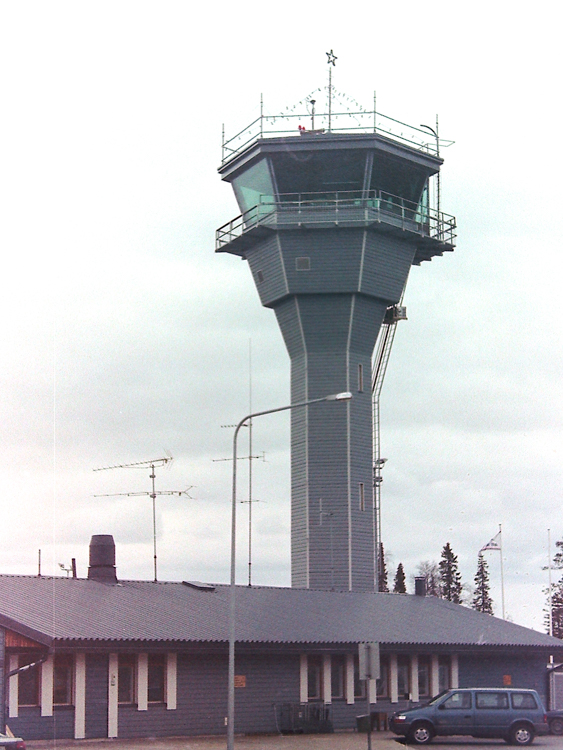
Kittila Airport control tower
Wood seemed to define the Finnish experience. There is nothing that cannot be constructed from it, given ample supplies and a bucketful of ingenuity. Not only the churches but the gravestones, not only the factories but the pipelines between them, not only railway sleepers but entire kilometres-long embankments are made from this amazing stuff. It can also be burned for warmth and fermented into fuel, and given the tiny number of Finns that live in the huge area north of Helsinki, there is an almost infinite supply.
The airport was deserted, and as the locals faded quickly away we realised that the single visible employee was from Avis and his single task for the day was to hand us the keys to our car. That done, he too disappeared, leaving us standing in the sunshine in a deserted airport, with only a single car waiting patiently for us in the car park.
A Lodge in Akaslompolo
It was a fair way to our rented lodge, but there was only one road and we amused ourselves by trying to spot fleeting glimpses of reindeer amongst the trees. Look, there’s one! No, that’s a tree stump No, it moved!
Of course, several days later we had acclimatised, and realised that the trouble with reindeer is to avoid running them over, as they seem to proliferate like rabbits, presumably an evolutionary compensation for their habit of standing still in the middle of the road.
The lodge, when we found it, was a log cabin set in woodland, furnished with modern conveniences and our very own sauna. It only took a moment to unpack, and then we set off to see what there was in Akoslompolo. There were a number of restaurants, a supermarket and an activity hire shop centred around a frozen lake. Pretty well perfect, except that nearly everything was firmly shut. The only thing that was open was one of the restaurants, and over an excellent meal of reindeer steak and wild berries we discovered that we had arrived in the off-season, a period of three weeks when the snow is no longer deep enough for skis and snowmobiles, but the ground is still too wet for walking or for wheeled traffic.
In fact, in those three short weeks a country of frozen ice is reborn violently as a country of lakes and woodland. Its all such an upheaval that the Finns, whose main income is tourism (in the skiing season) and tourism (in the walking season), all choose this time to seal up their houses and go on holiday.
It was certainly a time of changes. Every morning the scenery outside the lodge had altered, and each day driving along the same road was like exploring new territory. A snow covered woodland that we stamped about in throwing snowballs on one day, was a boiling torrent on the next, and a placid lake a couple of days later.

Reinhard on ice
A Trip to the Arctic Ice Pack
All this put an idea into my head. I wondered if the Barents Sea was still frozen, and if the sea-ice was also breaking up. When asked, various Finns scratched their heads and deliberated, and some were of the opinion that it had already melted, while others thought that you could probably still see the ice pack from the northern Norwegian shore. The only real way of finding out was to go and look, which in any case was inevitable as I’d always wanted to go to Kirkenes on the Norwegian / Russian border, ever since discovering that it was the last stopping point of the famous Norwegian Hurtigrute postal steamer.
The fact that we were going to be driving for twelve hours didn’t put us off, because of course this was the land of the midnight sun, and we had already adjusted to the pattern of sleeping when tired and emerging when awake regardless of the hour of the day.
Five hours of driving took us to the Norwegian border, where we realised that we hadn’t brought our passports, but of course nobody was there to check them. We were now seriously far north, where the coast of Norway curves around the tip of Finland to gently poke against the vastness of Russia.
For some time, we had been following a large frozen river, scattered with tree trunks and the debris of winter. Occasionally it expanded into a huge lake, criss-crossed by a season’s worth of fossilised snowmobile tracks. Apart from these tracks and the road itself, we had seen few signs of human habitation for hundreds of kilometres, and then suddenly there was a lay-by with half a dozen cars and a scattering of warmly clad families.
Intrigued, we pulled over to see what the fuss was about. The river was melting. The lay-by overlooked a gorge that channelled a fierce torrent of icy melt water. While the families peered timorously over the edge, we clambered down to what could loosely be called the waterline to get a closer look. The river roared with the speed of a train through a cut several hundred meters across. The water was laden with blocks of ice the size of snooker tables all moving at the same breakneck speed, rolling over and smashing into each other as they went. Where rocks obstructed their progress, massive chunks of ice reared inexorably out of the water, quivering with the warring forces, until the next one smashed them free or rode up over the top of them to form a huge unstable pile the size of several cars. We took some photos which we knew would never do justice to the scale or to the power, but we also realised that we were most unlikely ever to forget it.
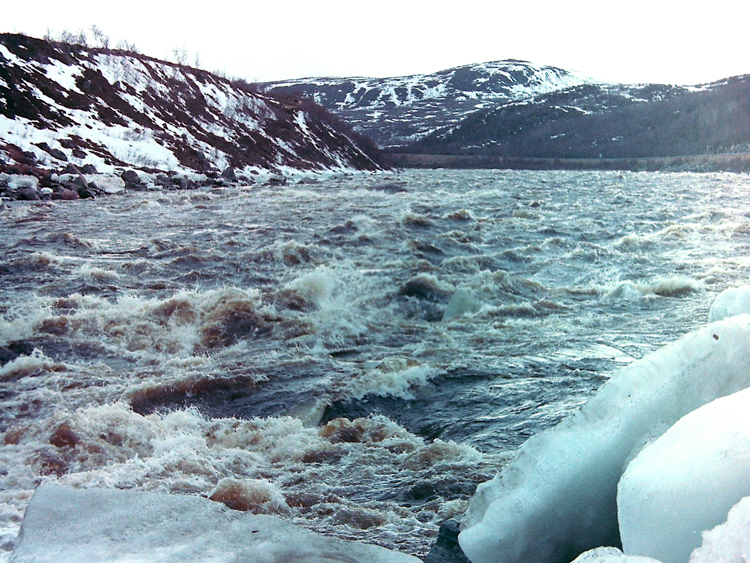
Melt water
Back on the road, we had run out of trees, and were driving through kilometres of scoured rock, tortured by volcanic stresses into brightly coloured reds and greens squeezed as if from a careless artist’s tube, and then flattened and shattered by the onslaught of water and ice. Sparsely scattered homesteads clung to the rock or projected out into lake and fjord on wooden stilts. This must be a truly harsh place to live.
Finally we rounded Hardanger Fjord, and the cold grey Barings Sea stretched out before us. Although it was free of ice, it had fulfilled its purpose; the excuse for a journey that otherwise we may never have made. We sat and watched it for a while, and then turned back to the south.
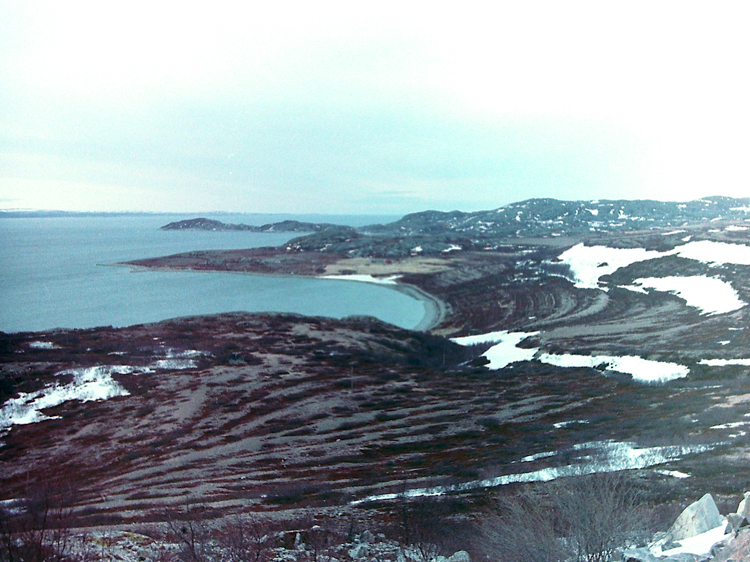
The view toward Russia; Hardinger Fjord on the Baring Sea
We re-entered Finland by a different route, and before we reached the tree line we puzzled over the strangeness of the landscape. It was hard to put your finger on it, but there was something offbeat about the scattered rocks, and then suddenly it clicked into place. The predominant weathering here was repeated freezing and thawing. More normal weathering, such as rain, wind and sun, was completely eclipsed here in the farthest reaches of Europe. The flat ice-scoured terrain bore strange collections of carefully graded rocks and pebbles, arranged into neat geometric patterns, usually circles a few feet across. The shores of the frozen lakes appeared manicured, so precise was the arrangement of the stones on the beach, sorted by size as if by some autistic child of the gods.
This was the effect of the permafrost layer, repeatedly pushing to the surface and then retreating, slowly but surely reorganising the rocks in the soil. Back in the tree line we found that things had changed again in the day we’d been away. The snow was melting with a vengeance, and many of the trees which had previously in deep snow were now standing up to their knees in melt water. Also emerging from the drift was a lakeside hut, built from split logs in the shape of a tepee and kitted out with a fire pit and pans.
Walking on Water
A few days later we returned to the tepee with firewood and food and Finnish beer for a lakeside meal. In the middle of the lake was a volcanic island, and to enable tourists to view the lava, a raised plank-way had been built over the boggy bits. However, this was intended for summer use, and just now the lake covered everything, boggy bits and all, with icy melt water. The planks had worked their way loose from their trestles over the winter, and were now floating in a surreal curve on the surface of the water, bobbing for a couple of hundred metres and only attached at each end to the shore and to the island.
It was impossible to resist. We built a big fire in the hut to dry us out on our return, and then set off walking on water, shuffling along with one foot on each of the thin planks. Amazingly, we made it to the island relatively unscathed, but the planks were only joined end-to-end by luck and inertia, so when we turned round to look the way we had come it was to see several of the planks floating off into the distance.
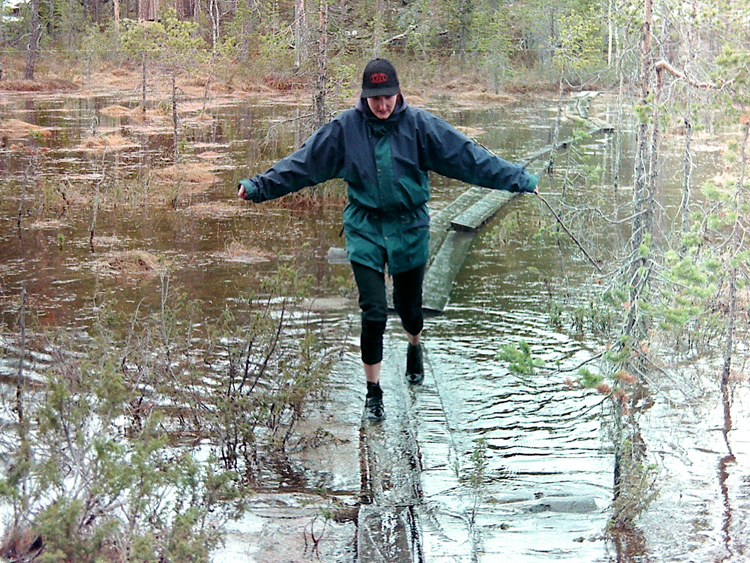
Lisa walks on water
Still, for most of the path there was still at least one plank still in place, and its amazing how the thought of glacial water improves your balance so we made it back only wet to the calves, apart from one of Lisa’s knees that got wet when the two planks she was standing on started floating in different directions…
This wasn’t the only day we spent with cold feet. On one occasion we were many kilometres up a flooded and frozen road that was technically still closed for winter, and stopped the car at the lip of a valley full of snow. We spent some time stomping around in it trying to work out if a front-wheel drive estate car would get through (we decided it wouldn’t). Another time was on our mountain bike excursion up, well, a mountain, during which I attempted to jump my bike over a snow-topped drainage ditch, with predictable results.
The Bear Hunt
One area of woodland was noted for its visiting bears, and in fact there was a path called The Bear Trail that wound around through six kilometres of pleasant birch forest. At least, it did in the summer season. When we tried it, the snow varied from ankle to waist deep and was undercut by varying depths of freezing melt water. It was only because the trail was marked by head-high paint marks on the trees that we could find it at all, and it took us most of the day, building bridges over the bad bits with fallen trees, jumping from rock to hidden rock, and of course keeping a wary eye out for bears.
We never saw any, which was probably best all round, but we did see lots of bear tracks, some of them made by a bear apparently dragging something, and we found ample evidence to finally resolve the age old question; yes, bears really do, there in the woods. I guess that makes the Pope a Catholic.
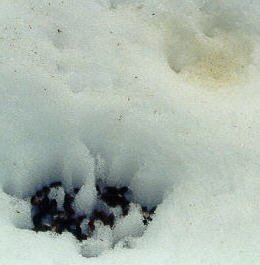
Oh yes they do